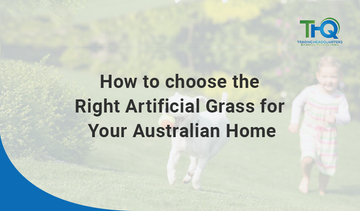For example, artificial grass that performs well in Perth’s hot, dry summers may struggle in Brisbane’s humid, subtropical climate. Similarly, understanding the advantages of wall cladding. such as its ability to provide UV resistance, heat absorption, and effective drainage is vital to ensuring both your lawn and building exterior remain durable and functional in varying weather conditions.
In this article, we will discuss the considerations for choosing the right artificial grass for your Australian home.
Understanding the artificial grass
Artificial grass, often referred to as synthetic turf, is a highly versatile and practical alternative to natural grass, gaining significant popularity in recent years. You can easily purchase artificial grass from THQ, making it a convenient option for various applications. Unlike its organic counterpart, artificial grass is meticulously engineered using advanced materials and manufacturing techniques to create a lush, green surface that closely mimics the appearance and feel of real grass.
At its core, artificial grass is composed of durable, resilient synthetic fibres, often made from polyethene or polypropylene, that are tufted into a permeable backing material. This foundation is then topped with a layer of crushed rubber or sand infill, which not only provides cushioning and stability but also helps the grass blades stand upright for a natural, uniform look.
The result is a low-maintenance, all-weather option that can withstand heavy foot traffic, resist fading from UV exposure, and eliminate the need for watering, mowing, or pesticide application.
Homeowners, businesses, and sports facilities alike have embraced artificial grass for its myriad benefits, from its consistent, pristine appearance to its long-lasting durability and ease of care.
Factors to consider when choosing artificial grass
When selecting artificial grass, there are several key factors to carefully consider to ensure you make the best choice for your specific needs and preferences.
First and foremost, it's important to think about the intended use of the space - will the artificial grass be in a high-traffic area that needs to withstand heavy use, or a more ornamental space with lighter foot traffic? The durability and pile height of the synthetic turf can vary significantly, so selecting the right product for the application is crucial.
Additionally, the climate and weather conditions of the location should be taken into account, as certain artificial grass materials may perform better in hot, sunny environments versus cooler, wetter climates.
Aesthetics are also a major consideration—the colour, texture, and overall look and feel of the artificial grass should complement the surrounding landscape, architectural cladding, and architectural style.
Factors like infill, drainage, and installation requirements are also important variables to weigh, as they can impact both the initial cost as well as the long-term maintenance needs.
By thoughtfully evaluating all of these elements, homeowners and landscape designers can choose the ideal artificial grass solution that will provide a lush, inviting, and low-maintenance green space for years to come.
Popular types of artificial grass in
Australia
Artificial grass has become increasingly popular in Australia in recent years, with a wide variety of options available to homeowners and landscapers. One of the most common types is a lush, dense variety that closely mimics the look and feel of natural turf.
This high-quality synthetic grass features individual blades that are soft to the touch and stand up tall, creating a plush, inviting surface perfect for yards, parks, and sports fields.
Another popular choice is a shorter, more uniform artificial grass that provides a neat, tidy appearance, ideal for low-maintenance gardens or commercial properties. These options often have a flatter, almost carpet-like texture that is durable and resilient against heavy foot traffic.
For those seeking a more natural aesthetic, there are also artificial grasses designed to replicate the varied shades and uneven growth patterns of real grass, complete with subtle undulations and blended hues that give an authentic, lived-in look.
No matter the specific style, all of these artificial turf products offer the key benefits of low upkeep, year-round green colour, and resistance to damage from weather, pests, and wear and tear that can plague natural lawns. As a result, they have become a popular, practical choice for creating lush, inviting outdoor spaces throughout Australia.
Installation considerations DIY vs professional installation
When it comes to installing artificial grass, homeowners have the choice between tackling the project as a DIY endeavour or opting for professional installation. Both paths come with their unique considerations and implications.
For the DIY route, the appeal lies in the potential cost savings and the sense of personal accomplishment in completing the installation oneself. However, this approach also requires a significant investment of time and effort, as well as a certain level of technical expertise to ensure the artificial turf is properly laid and secured.
Improper installation can lead to unsightly wrinkles, gaps, or uneven surfaces that detract from the lush, seamless appearance that artificial grass is known for. In contrast, professional installation by experienced technicians offers a streamlined, efficient process with a guaranteed high-quality finish.
While this option typically carries a higher price tag, it eliminates the need for homeowners to acquire specialized tools and materials or master intricate installation techniques.
Professionals also have the expertise to address any unique challenges your landscape may present, such as sloping terrain or existing hardscaping features. If you're thinking about purchasing artificial grass in cranbourne or anywhere across Australia, their knowledge can ensure a seamless installation tailored to your needs.
Ultimately, the decision between DIY and professional installation comes down to the homeowner's comfort level, available time, budget, and desired level of confidence in the final result.
Careful consideration of these factors can help ensure a successful artificial grass project that meets the homeowner's expectations and delivers long-lasting, low-maintenance beauty to the outdoor space.
Maintenance tips
Maintaining the lush, verdant appearance of artificial grass requires a bit of diligent care and attention, but the payoff is well worth the effort. Unlike natural grass, which needs regular mowing, watering, and re-seeding, artificial turf is a remarkably low-maintenance alternative that can retain its pristine, unblemished look for years with the right upkeep.
The first key step is to routinely brush the grass blades to prevent matting and keep the surface looking fresh and uniform. This can be done with a stiff-bristled broom or a specialized power groomer, which will lift the fibres back up and evenly distribute the infill material underneath.
It's also important to clear away any accumulated debris, such as leaves, twigs, or pet waste, to avoid discolouration or odours. For high-traffic areas, periodic light raking can help restore the grass's resilience and bounce.
Additionally, artificial grass should be hosed down regularly to wash away dirt, pollen, and other grime that can dull its vibrant green hue.
With just these simple maintenance tasks performed a few times per year, homeowners can effortlessly preserve the immaculate, natural-looking lawn they desire without the hassle of mowing, watering, and other demanding upkeep associated with real grass.
Environmental impact
The use of artificial grass has become an increasingly popular environmental initiative in recent years as more communities and homeowners seek to reduce their impact on natural resources.
Unlike traditional grass lawns, which require constant watering, mowing, and the use of fertilizers and pesticides, artificial grass provides a lush, green alternative that requires minimal maintenance and no water usage.
The synthetic fibres that make up artificial grass are designed to mimic the look and feel of real grass but without the need for constant upkeep. This not only saves homeowners time and money but also significantly reduces the environmental toll of lawn care.
Many artificial grass products are also made from recycled materials, further enhancing their eco-friendly credentials. Additionally, artificial grass doesn't contribute to the release of greenhouse gases through decomposition like natural grass, and it prevents soil erosion that can pollute local waterways.
As water scarcity becomes an increasingly pressing issue worldwide, artificial grass offers a water-efficient solution for landscaping that helps conserve this vital resource. For people all over Australia, including those looking to buy artificial grass in somerton, this sustainable option allows you to maintain a green and attractive outdoor space without relying on traditional watering methods.
Overall, the environmental benefits of artificial grass, from reduced resource consumption to decreased pollution, have made it a go-to choice for eco-conscious homeowners and communities seeking to green their spaces sustainably.
Conclusion
When choosing artificial grass for your outdoor space, there are several key factors to carefully consider. Firstly, the material composition of the grass is crucial - you'll want to select a high-quality synthetic turf that is durable, weather-resistant, and feels soft and natural underfoot.
The density and length of the grass blades can also greatly impact the overall look and feel, with longer, more lush grass creating a more realistic appearance.
Additionally, the infill material used to provide cushioning and support is an important consideration - options like rubber or sand can offer different levels of comfort and drainage.
Beyond the physical attributes, it's also wise to think about the maintenance requirements of the artificial grass, as some varieties may need more frequent cleaning or grooming than others. And of course, the cost is a significant factor, as artificial lawns can vary widely in price depending on the quality and features.
By closely evaluating all of these essential elements - from the materials and construction to the ongoing care and financial investment - you can ensure you select the perfect artificial grass solution to beautifully transform your outdoor living space for years to come.






